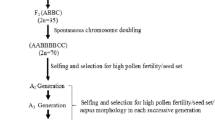Abstract
Meiotic chromosome behaviour was studied in the hexaploid Hordeum parodii (2n=6x=42) and in six haploids (2n=3x=21) obtained from a cross between H. parodii and H. bulbosum (2n=2x=14) whereby all bulbosum chromosomes were selectively eliminated. The alloploid nature of H. parodii was evident from the exclusive bivalent formation at the hexaploid level and the low and variable number of bivalents in its haploid derivatives. In haploids, both nonhomologous (intragenomic) and homoeologous (intergenomic) chromosomes paired at prophase. Foldbacks in single chromosomes, bivalents and trivalents were observed at prophase and metaphase I. At diakinesis, the associations involved a maximum of 20 chromosomes which decreased to 12 by metaphase I. This decrease was attributed to the failure of the non-homologous associations to persist until metaphase I. A “hemizygous-ineffective” control for the diploid-like behaviour of the hexaploid parodii is proposed to explain the homeologous chromosome pairing in its haploid derivatives.
Similar content being viewed by others
References
Dover, G.A., Riley, R.: Inferences from genetical evidence on the course of meiotic chromosome pairing in plants. Phil. Trans. B 277, 313–326 (1977)
Finch, R.A., Kasha, K.J.: Maiotic associations in barley lines with eight pairs of chromosomes and their haploids. Canad. J. Genet. Cytol. 18, 753–761 (1976)
Gauthier, F.M., McGinnis, R.C.: The meiotic behaviour of a nullihaploid plant in Avena sativa L. Canad. J. Genet. Cytol. 10, 186–189 (1968)
Islam, R., Sparrow, D.B.H.: Chromosome elimination in interspecific hybrids involving Hordeum arizonicum (6x) x H. vulgare (2x) and H. arizonicum (6x) x H. bulbosum (2x). Barley Genet. Newsl. 4, 36–37 (1974)
Jauhar, P.P.: Genetic control of diploid-like meiosis in hexaploid tall fescue. Nature (Lond.) 254, 595–597 (1975)
Kao, K.N., Kasha, K.J.: Haploid from interspecific crosses with tetraploid barley. Barley Genetics 2, 82–87 (1969)
Kasha, K.J., Kao, K.N.: High frequency haploid production in barley (Hordeum vulgare L.). Nature (Lond.) 225, 874–876 (1970)
Lange, W.: Crosses between Hordeum vulgare L. and H. bulbosum L.I. Production, morphology and meiosis of hybrids, haploids and dihaploids. Euphytica (Wageningen) 20, 14–29 (1971a)
Lange, W.: Crosses between Hordeum vulgare and H. bulbosum L. II. Elimination of chromosomes in hybrid tissues. Euphytica (Wageningen) 20, 181–194 (1971b)
Levan, A.: Studies on the meiotic mechanism of haploid rye. Hereditas (Lund.) 28, 177–211 (1942)
Maguire, M.P.: Homologous chromosome pairing. Phil. Trans. B 277, 245–258 (1977)
Malik, C.P., Tripathi, R.C.: Mode of chromosome pairing in the polyhaploid tall fescue (Festuca arundinacea Schreb. 2n=42). Z. Biol. 116, 332–339 (1970)
Miller, T.E., Chapman, V.: Aneuhaploids in bread wheat. Genet. Res. (Camb.) 28, 37–45 (1976)
Nishiyama, I., Tabata, M.: Cytogenetic studies in Avena XII. Meiotic chromosome behaviour in a haploid cultivated oat. Jap. J. Genet. 38, 311–316 (1964)
Rajhathy, T., Morrison, J.W., Symko, S.: Interspecific and intergeneric hybrids in Hordeum. Barley Genetics 1, 195–212. (1963)
Rajhathy, T., Symko, S.: High frequency of haploids from crosses of Hordeum lechleri (6x) x H. vulgare (2x) and H. jubatum (4x) x H. bulbosum (2x). Canad. J. Genet. Cytol. 16, 468–472 (1974)
Rajhathy, T., Thomas, H.: Genetic control of chromosome pairing in hexaploid oats. Nature (Lond.) New Biol. 239, 217–219 (1972)
Rieger, R.: Inhomologenpaarung und Meioseablauf bei haploiden Formen von Antirrhinum majus L. Chromosoma (Berl.) 9, 1–38 (1957)
Riley, R.: The diploidization of polyploid wheat. Heredity 15, 407–429 (1960)
Riley, R., Chapman, V.: Haploids and polyhaploids in Aegilops and Triticum. Heredity 11, 195–207 (1957)
Riley, R., Chapman, V.: Genetic Control of the cytologically diploid behaviour of hexaploid wheat. Nature (Lond.) 182, 713–715 (1958)
Sadasivaiah, R.S., Kasha, K.J.: Meiosis in haploid barley—an interpretation of non-homologous chromosome associations. Chromosoma (Berl.) 35, 247–263 (1971)
Sadasivaiah, R.S., Kasha, K.J.: Non-homologous associations of haploid barley chromosomes in the cytoplasm of Hordeum bulbosum L. Canad. J. Genet. Cytol. 15, 45–52 (1973)
Snow, R.: Alcoholic hydrochloric acid-carmine as a stain for chromosome squash preparations. Stain Technol. 38, 9–13 (1963)
Starks, G.D., Tai, W.: Genome analysis of Hordeum jubatum and H. compressum. Canad. J. Genet. Cytol. 16, 663–668 (1974)
Subrahmanyam, N.C.: Interspecific hybridization, chromosome elimination and haploidy in Hordeum. Barley Genet. Newsl. 6, 69–70 (1976)
Subrahmanyam, N.C.: Haploidy from Hordeum interspecific crosses. I. Polyhaploids of H. parodii and H. procerum. Theor. Appl. Genet. 49, 209–217 (1977)
Subrahmanyam, N.C., Kasha, K.J.: Selective chromosomal elimination during haploid formation in barley following interspecific hybridization. Chromosoma (Berl.) 42, 111–125 (1973)
Weber, D.F., Alexander, D.E.: Redundant segments in Zea mays detected by translocations of monoploid origin. Chromosoma (Berl.) 39, 27–42 (1972)
Author information
Authors and Affiliations
Rights and permissions
About this article
Cite this article
Subrahmanyam, N.C. Meiosis in polyhaploid Hordeum: hemizygous ineffective control of diploid-like behaviour in a hexaploid?. Chromosoma 66, 185–192 (1978). https://doi.org/10.1007/BF00295139
Received:
Accepted:
Issue Date:
DOI: https://doi.org/10.1007/BF00295139




